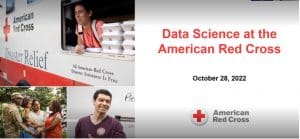Attending Data Science Day, made me realize how data has evolved to be an integral unit in business growth and humanitarian science! In fact, I have come to belief that: ‘The future looks like a place where data will rule our every decision.’
In other words, with the digitizing world, the hunger for data to drive substantial growth is crucial to many industries. This is not only in the for-profit corporate world, but also for non-for-profit organizations.
In fact, there are many examples of data and predictive analytics improving how people live, and even saving lives. Leveraging data analytics for relief in unforeseen circumstances is one of many wonders of data.
One such non-for-profit organization, The American Red Cross, is leveraging data to help inform community outcomes. The American Red Cross leverages data science to generate meaningful insights from its data repository, which contains demographic, humanitarian crisis, safety, and other data.

During Syracuse’s Data Science Day, I attended a talk by Bryan Shepherd from the American Red Cross.
Bryan noted that data science is used to improve public health and safety as well as contribute to improving the quality of life and reducing human hardship.
Furthermore, the American Red Cross uses data science in a range of activities, ranging from improving blood donations to emergency preparedness and relief.
More generally, the American Red Cross’s mission is to educate the public, provide aid in developmental growth, help inform the government on policies, and advance clinical research.
Data Science and Blood Donations
With data growing and data science evolving and growing in importance, I realized that organizations like the American Red Cross are leveraging data to conduct processing and gain insights into measurements from healthy blood donors. That helps to study the variation of hemoglobin levels by changes in altitude, geographic location, seasonal variations, age, race, and sex.
The American Red Cross smartly uses data collected through its blood donation campaign. Data science applications on the data obtained from the campaign provide insights into the prevalence of health markers for infectious diseases, such as HBV, HCV, HIV, WNV, Syphilis, and CMV.
With the recent pandemic, which hit the world harder, American Red Cross contributed to responding to health emergency threats to the blood supply. The Red Cross, through data analysis, performs scientific studies with a particular focus on mechanisms underlying and preventing infectious complications and driving innovation in blood products. They are using data to support their goal of establishing tomorrow’s transfusion therapies to achieve better patient care.
Data Science and Emergencies
The Red Cross also promotes awareness of health hazards by delivering insights into trends apparent in data, which may influence government policies, inform educational programs, promote research in diseases and injury prevention, and supplement existing surveillance programs.
The Red Cross leverages data science to analyze data, find actionable insights, and make its Home Fire Campaign, a success. Data science helps to get an idea of the number of homes that require Home Fire Campaign services. The agenda is to save lives by installing safety measures for household fires. The Red Cross investigates the cases & collects data with the support of local fire departments. The data collection includes the total number of cases, the number of lives saved, and youth lives rescued at the city and state levels.
An Example: Fire Prevention
Three thousand and eight hundred people died because of a fire in the United States in 2021, which The Red Cross is trying to prevent through their data-driven analyses.
Through Home Fire Campaign Red Cross has installed around 2040419 fire alarms nationally. They have saved 934266 households nationally. They provide HFC services before a home fire and assure residents’ safety. Yet again, how data is beneficial in saving lives is something I never thought could happen before getting exposed to data analyses.
Final Thoughts
Data has evolved from just being called data; it is the data. With prominence in guiding decisions on various levels and domains, data is now the tool for measurements. Data can help set benchmarks and performance goals to help organizations move forward. Since data is now the dominant factor, data science is the future. From small businesses to large, from saving lives to providing relief, fraud detection to happiness index, and whatnot, data science has to be everywhere to sustain growth in the future.
With all said, one thing that challenges data science is ethics. In particular, privacy rights, data validity, and algorithm fairness in Big Data Analysis, Artificial Intelligence, and Machine Learning are the most important ethical challenges that require a more thorough investigation. Organizations must inculcate core ethical principles of fairness, privacy, transparency, and accountability in their AI models. The organization’s output can retain trust in how they use their data—and thus build goodwill and loyalty, which enhances their reputation and brand value.
Conclusively, the world is one big data problem – Andrew McAfee, co-director of the MIT Initiative.
